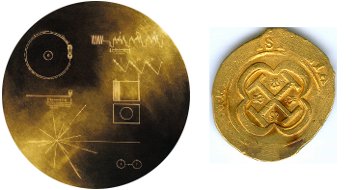Characteristics:
Gold is an excellent conductor of heat and electricity.
It is a soft, yellow, metal with a beautiful lustrous sheen. It is the most malleable and ductile of all the elements and a single gram can be beaten into a sheet one square meter sheet of gold leaf.
Gold has a very high density, 19.32 g/cm3. (A tennis ball sized sphere of gold would weigh about 5.7 pounds (2.6 kilograms). Gold is not the densest natural element, however. That honor belongs to osmium, followed very closely by iridium. Tennis ball sized spheres of these elements would each weigh about 6.8 pounds (3.1 kilograms).
Gold is unaffected by air, water, alkalis and all acids except aqua regia (a mixture of hydrochloric acid and nitric acid) which can dissolve gold. Gold does react with halogens. It will, for example, react very slowly with chlorine gas at room temperature to form gold chloride, AuCl3. If gold chloride is heated gently, it will decompose to release the pure elements again.
Unusually for a metal, gold can also form compounds (aurides) in which its oxidation number is negative (-1). For example, gold can combine with cesium to form cesium auride, CsAu, and rubidium to form rubidium auride, RbAu. These are ionic compounds with non-metallic properties in which the Cs or Rb ions are charged +1 while the Au atoms are charged 1-.
Uses:
Gold is widely used in jewelry and coinage. It is also used in dental work as crowns, as gold plating for decoration and as gold thread in embroidery work. The gold content in alloys is usually measured in carats (k), with pure gold defined as 24k.
Many satellites carry gold-coated mylar sheets as a solar heat shield because gold is an excellent reflector of radiation and unreactive. Similarly astronaut's helmet visors are coated with a thin layer of gold to guard against dangerous effects of solar radiation.
Gold is used widely in microelectronic circuits to ensure reliable, corrosion-resistant and static-free performance.
The isotope 198Au, with a half-life of 2.7 days, is used for treating cancers - especially of the bladder, cervix, and prostate.
Gold flake is added to some gourmet sweets and drinks.
Chloroauric acid (HAuCl4) is used in photography for toning the silver image.
|
